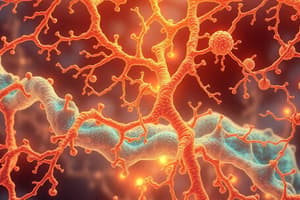Podcast
Questions and Answers
What are the main components of connective tissue?
What are the main components of connective tissue?
- Epithelium, muscle, and nervous tissue
- Cartilage, bone, and blood
- Matrix, fibers, and cells (correct)
- Blood, lymph, and bone marrow
The intercellular substance in connective tissue is very abundant compared to that in epithelium.
The intercellular substance in connective tissue is very abundant compared to that in epithelium.
True (A)
What is the primary function of collagenous fibers?
What is the primary function of collagenous fibers?
Tensile strength
Which type of fibers is responsible for the elasticity of connective tissues?
Which type of fibers is responsible for the elasticity of connective tissues?
Match the connective tissue cells with their main function.
Match the connective tissue cells with their main function.
Flashcards
Connective Tissue
Connective Tissue
A type of tissue that provides support, defense, and nutrition.
Epithelium
Epithelium
Tightly packed cells with minimal intercellular substance and no fibers. Usually found as a lining.
Extracellular Matrix (Ground Substance)
Extracellular Matrix (Ground Substance)
The substance that fills the space between cells. Primarily composed of water, glycosaminoglycans, and glycoproteins.
Collagenous Fibers
Collagenous Fibers
Signup and view all the flashcards
Reticular Fibers
Reticular Fibers
Signup and view all the flashcards
Elastic Fibers
Elastic Fibers
Signup and view all the flashcards
Undifferentiated Mesenchymal Cell
Undifferentiated Mesenchymal Cell
Signup and view all the flashcards
Fibroblast
Fibroblast
Signup and view all the flashcards
Fibrocyte
Fibrocyte
Signup and view all the flashcards
Macrophage
Macrophage
Signup and view all the flashcards
Mast Cell
Mast Cell
Signup and view all the flashcards
Plasma Cell
Plasma Cell
Signup and view all the flashcards
Fat Cell (Adipocyte)
Fat Cell (Adipocyte)
Signup and view all the flashcards
Loose Connective Tissue
Loose Connective Tissue
Signup and view all the flashcards
Dense Connective Tissue
Dense Connective Tissue
Signup and view all the flashcards
Dense Regular Connective Tissue
Dense Regular Connective Tissue
Signup and view all the flashcards
Dense Irregular Connective Tissue
Dense Irregular Connective Tissue
Signup and view all the flashcards
Reticular Connective Tissue
Reticular Connective Tissue
Signup and view all the flashcards
Elastic Connective Tissue
Elastic Connective Tissue
Signup and view all the flashcards
Adipose Connective Tissue
Adipose Connective Tissue
Signup and view all the flashcards
Blood
Blood
Signup and view all the flashcards
Cartilage
Cartilage
Signup and view all the flashcards
Bone
Bone
Signup and view all the flashcards
Study Notes
Connective Tissue Overview
- Connective tissue differs from epithelium, characterized by scattered cells surrounded by an abundant extracellular matrix
- The matrix consists of ground substance (mainly water, glycosaminoglycans, and glycoproteins) and fibers (collagenous, reticular, and elastic).
- Connective tissue functions in support, defense, and nutrition.
Connective Tissue Constituents
- Matrix: Composed predominantly of water, glycosaminoglycans, and glycoproteins.
- Fibers: Collagenous fibers provide tensile strength, reticular fibers form supportive frameworks, and elastic fibers offer elasticity.
- Cells: Vary depending on the specific connective tissue type.
Extracellular Matrix (Ground Substance)
- Primarily composed of water.
- Contains glycosaminoglycans and glycoproteins.
- Similar in composition to blood plasma.
- Functions include nutrition and acting as a barrier to bacterial penetration.
Connective Tissue Fibers
- Collagenous fibers: Most abundant, strong, and flexible. Their fibers do not branch, but bundles can.
- Reticular fibers: Thin, branching, stained dark brown with silver stain, function in support.
- Elastic fibers: Yellow in large numbers, elastic and stretchable, stained brick red by orcein and dark violet by V.V.G stain.
Connective Tissue Cells
- Function, structure (light microscopy (LM) and electron microscopy (EM)), and origin vary widely.
Undifferentiated Mesenchymal Cell
- Spindle-shaped, many processes.
- Oval nucleus, basophilic cytoplasm.
- Divide and differentiate into other connective tissue cells.
Fibroblasts
- Two types: Young and mature.
- Young fibroblasts have spindle shapes with processes, oval central paler nuclei, basophilic cytoplasm; function in synthesis of connective tissue.
- Mature fibroblasts (fibrocytes) have smaller spindle shapes with processes, oval central darker nuclei, acidophilic cytoplasm.
Macrophages
- Psuedopodea with a kidney-shaped, eccentric nuclei.
- Large number of secondary lysosomes.
- Function in phagocytosis.
Mast Cells
- Largest of free cells.
- Contain basophilic granules stained red with toluidine blue (metachromatic staining).
- Central rounded nucleus.
- Function in secretion of histamine.
Plasma Cells
- Large, ovoid cells.
- Basophilic cytoplasm (rER), spherical eccentric nuclei.
- Cartwheel appearance of the nucleus.
- Function in antibody formation.
Adipocytes
- Large, spherical or polyhedral cells containing single or several lipid droplets.
- Flattened peripheral nuclei.
- Function in lipid storage.
Types of Connective Tissue Proper
- Loose areolar connective tissue: Contains all fiber types and abundant ground substance; found in lamina propria and papillary dermis of the skin.
- Dense regular connective tissue: Collagenous fibers are arranged parallel; found in tendons and ligaments.
- Dense irregular connective tissue: Collagenous fibers run in all directions; found in the deep dermis of skin and capsules of lymph nodes.
- Reticular connective tissue: Composed of reticular fibers; found in liver, lymphoid tissue, and bone marrow.
- Elastic connective tissue: Contains elastic fibers, which run parallel or in a wavy pattern; found in large arteries and vocal cords.
- Adipose connective tissue: Contains adipocytes (fat cells); found in subcutaneous tissue and surrounding vital organs.
Studying That Suits You
Use AI to generate personalized quizzes and flashcards to suit your learning preferences.




